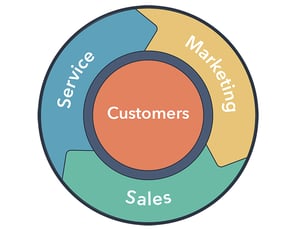Inbound marketing-metoden
Inbound marketing is a systematic approach to marketing, where the marketing efforts are divided into four phases, as shown in the model to the right.
Let's take a closer look at these four phases.
The first phase is about attracting new visitors to your company's website. A corporate blog is a key tool in this phase. The corporate blog is an online collection of articles that answers the most important questions your target audience has – the most cost-effective way to build organic visibility in search engines.
We've seen companies multiply their traffic in the first year of inbound, and Intuvio has more than 10x'd traffic since we started with inbound marketing in 2015. The speed at which traffic grows depends, among other factors, on how often you publish new content. A frequency of 1-2 articles per week is a normal ambition level for many companies starting with inbound marketing.
In some highly competitive industries, it may take longer to rank high on Google than in others. In such cases, you can buy distribution through social media advertising (e.g., Facebook Ads) or in online newspapers (native advertising).
Convert
Studies show that only 4% of visitors to your site are ready to buy. This is naturally dependent on the product and industry, but regardless, the purchase-ready visitors make up a very small percentage of visits. To engage this small group, you need clear positioning and make it easy for them to contact you – but what about the other 96% who aren't ready to buy? How do you get them to identify themselves so you can nurture and follow up with them over time as they get closer to making a purchase decision?
You need to convert these visitors into leads – in other words, get them to exchange their contact information for something they perceive as valuable. It could be an e-book, a report, a video, a webinar, a product demo, or a free consultation. The key is offering value and ensuring that what you offer moves them further down the sales funnel.
To convert visitors into leads, we use so-called CTAs (Calls To Action). These are buttons or banners typically placed at the bottom of an article on your corporate blog and serve as ads for the content you want in exchange for contact details. When a visitor clicks on the CTA, they are taken directly to a landing page where they are asked to fill out a form to receive the content. Once the form is submitted, the contact is registered in your CRM system as a lead and automatically receives the requested content.
Sell
According to Gleanster Research, 50% of potential customers who reach out are qualified but not yet ready to make a purchase decision. How do you move them forward? The answer is **lead nurturing** – a process that turns a cold inquiry into a warm sales opportunity.
Another term for lead nurturing is a **dialogue flow**. Simply put, it's an automated process that nurtures leads until they become sales-qualified leads (SQLs), leads that are worth investing time in by a salesperson.
To effectively work with dialogue flows, you need a marketing automation system like HubSpot. The system captures new leads and manages them through 1:1 communication via email, from the initial inquiry to when they become customers.
When a potential customer shows a profile indicating they are a match for your business (interest) and demonstrates digital behavior suggesting they are ready to be contacted (engaged), they will be marked as a sales-qualified lead in the CRM – and sales takes over the process with personalized 1:1 follow-up until they become a customer.
It's crucial to have a clear definition of **when** a lead should be defined as sales-qualified (SQL), to clarify the responsibilities of marketing and sales and avoid conflicts and misunderstandings between departments. This is where the "handover" from marketing to sales occurs.
Delight
As mentioned in the introduction, satisfied customers are your best ambassadors and marketers. **Customer satisfaction** breeds customer loyalty, which is one of the strongest drivers of profitability – and measuring this, for example through **Net Promoter Score (NPS)**, can be a smart investment. With fast, accessible, and problem-oriented customer service, and products and services that meet or exceed expectations, you’re already halfway there. Even the best marketing campaign can't save a bad product or prevent bad reviews or press coverage.






